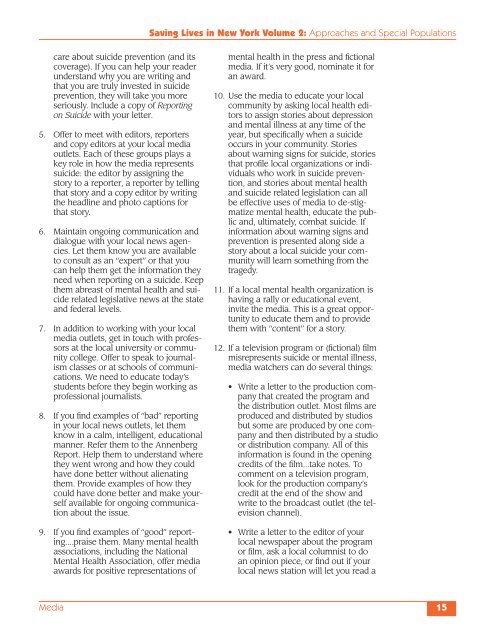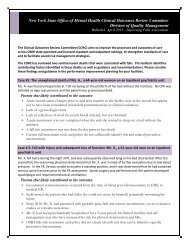Download - New York State Office of Mental Health
Download - New York State Office of Mental Health
Download - New York State Office of Mental Health
You also want an ePaper? Increase the reach of your titles
YUMPU automatically turns print PDFs into web optimized ePapers that Google loves.
Saving Lives in <strong>New</strong> <strong>York</strong> Volume 2: Approaches and Special Populations<br />
care about suicide prevention (and its<br />
coverage). If you can help your reader<br />
understand why you are writing and<br />
that you are truly invested in suicide<br />
prevention, they will take you more<br />
seriously. Include a copy <strong>of</strong> Reporting<br />
on Suicide with your letter.<br />
5. Offer to meet with editors, reporters<br />
and copy editors at your local media<br />
outlets. Each <strong>of</strong> these groups plays a<br />
key role in how the media represents<br />
suicide: the editor by assigning the<br />
story to a reporter, a reporter by telling<br />
that story and a copy editor by writing<br />
the headline and photo captions for<br />
that story.<br />
6. Maintain ongoing communication and<br />
dialogue with your local news agencies.<br />
Let them know you are available<br />
to consult as an “expert” or that you<br />
can help them get the information they<br />
need when reporting on a suicide. Keep<br />
them abreast <strong>of</strong> mental health and suicide<br />
related legislative news at the state<br />
and federal levels.<br />
7. In addition to working with your local<br />
media outlets, get in touch with pr<strong>of</strong>essors<br />
at the local university or community<br />
college. Offer to speak to journalism<br />
classes or at schools <strong>of</strong> communications.<br />
We need to educate today’s<br />
students before they begin working as<br />
pr<strong>of</strong>essional journalists.<br />
8. If you find examples <strong>of</strong> “bad” reporting<br />
in your local news outlets, let them<br />
know in a calm, intelligent, educational<br />
manner. Refer them to the Annenberg<br />
Report. Help them to understand where<br />
they went wrong and how they could<br />
have done better without alienating<br />
them. Provide examples <strong>of</strong> how they<br />
could have done better and make yourself<br />
available for ongoing communication<br />
about the issue.<br />
9. If you find examples <strong>of</strong> “good” reporting....praise<br />
them. Many mental health<br />
associations, including the National<br />
<strong>Mental</strong> <strong>Health</strong> Association, <strong>of</strong>fer media<br />
awards for positive representations <strong>of</strong><br />
mental health in the press and fictional<br />
media. If it’s very good, nominate it for<br />
an award.<br />
10. Use the media to educate your local<br />
community by asking local health editors<br />
to assign stories about depression<br />
and mental illness at any time <strong>of</strong> the<br />
year, but specifically when a suicide<br />
occurs in your community. Stories<br />
about warning signs for suicide, stories<br />
that pr<strong>of</strong>ile local organizations or individuals<br />
who work in suicide prevention,<br />
and stories about mental health<br />
and suicide related legislation can all<br />
be effective uses <strong>of</strong> media to de-stigmatize<br />
mental health, educate the public<br />
and, ultimately, combat suicide. If<br />
information about warning signs and<br />
prevention is presented along side a<br />
story about a local suicide your community<br />
will learn something from the<br />
tragedy.<br />
11. If a local mental health organization is<br />
having a rally or educational event,<br />
invite the media. This is a great opportunity<br />
to educate them and to provide<br />
them with “content” for a story.<br />
12. If a television program or (fictional) film<br />
misrepresents suicide or mental illness,<br />
media watchers can do several things:<br />
• Write a letter to the production company<br />
that created the program and<br />
the distribution outlet. Most films are<br />
produced and distributed by studios<br />
but some are produced by one company<br />
and then distributed by a studio<br />
or distribution company. All <strong>of</strong> this<br />
information is found in the opening<br />
credits <strong>of</strong> the film...take notes. To<br />
comment on a television program,<br />
look for the production company’s<br />
credit at the end <strong>of</strong> the show and<br />
write to the broadcast outlet (the television<br />
channel).<br />
• Write a letter to the editor <strong>of</strong> your<br />
local newspaper about the program<br />
or film, ask a local columnist to do<br />
an opinion piece, or find out if your<br />
local news station will let you read a<br />
Media 15

















